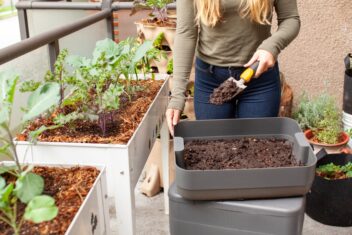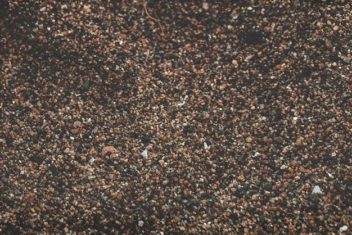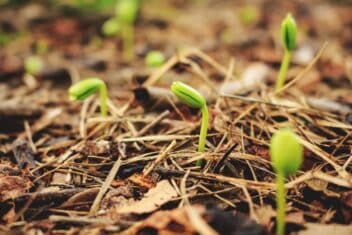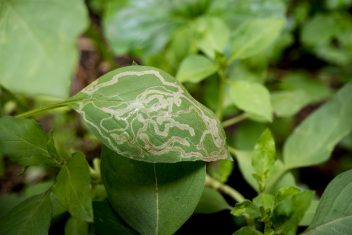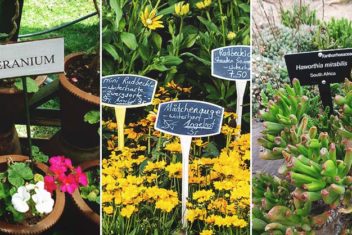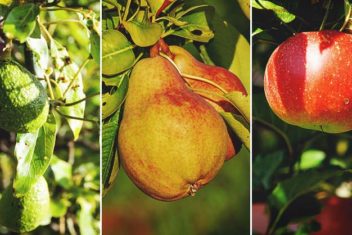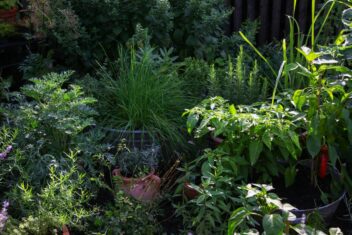You’ve planted your seeds, and they’re just starting to sprout when they suddenly turn brown and die. What’s going on? You may have fallen victim to damping off. Damping off is a collective term for several diseases that can kill young seedlings. It affects flowers, vegetables, herbs and fruits alike.
What happens is this: A fungus or parasite damages the base of the stem and the roots of a seedling. The stems turn to mush, and the fledgling plant dies. Damping off also happens in seeds. Initially, infected seeds look healthy. They’ll even germinate and start to grow. But then all of the sudden – nothing.
So what can you do? Not to worry, while damping off isn’t curable, it is preventable, and we’ll show you how.
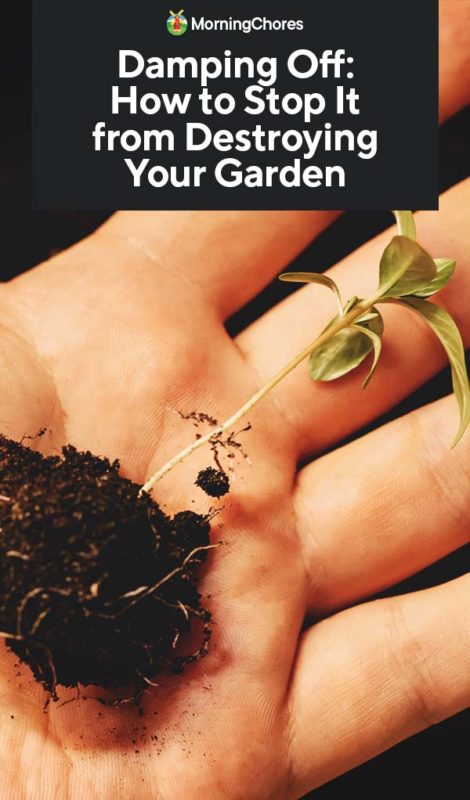
What Causes Damping Off?
The fungal and parasitic species Pythium, Rhizoctonia, Fusarium, and Phytophthora, are often the cause of damping off. They live in your garden soil, and when conditions are right, can grow and spread into your seedlings.
Note that these same organisms affect older plants as well. Crown rot is a soil-borne disease that damages plant roots, stunting their growth.
What conditions do they prefer? Poor drainage and cold, wet soil. Tackle these, and you’ll go a long way towards preventing damping off.
We’ll take a look at these specific organisms in more detail below.
Fusarium
Fusarium is a common type of fungi. Most species are harmless and eat decomposing plant matter which is good for your compost pile. However, many species can cause trouble.
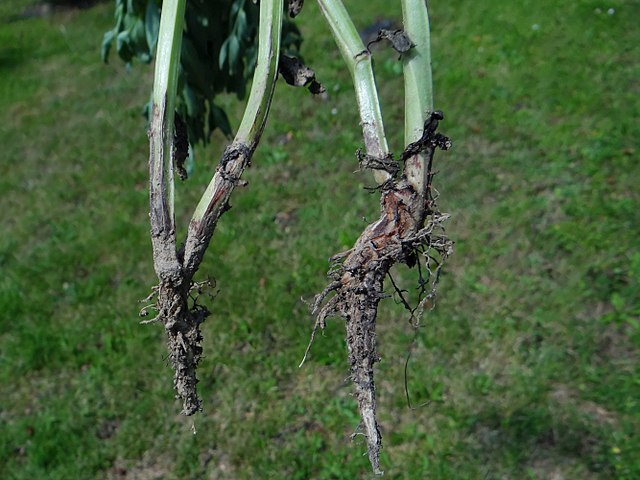
Fusarium has varieties which cause damping off and the dreaded tomato blight. You have probably seen seed catalogs where it says certain plant varieties are susceptible to fusarium wilt.
Pythium
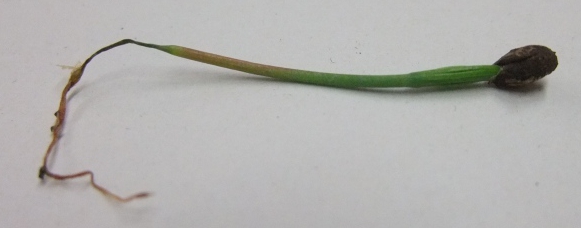
Pythium is a plant parasite that causes root rot. It preys on a wide range of plants. Not only does it live in soils but it can wreak havoc in your hydroponics system.
Rhizoctonia
Rhizoctonia means root killer in French, which is fitting because it lives in the soil waiting to destroy your seedlings. It causes damping-off as well as root rot in beets, black
Phytophthora
This mold’s name means “plant destroyer” in Greek. It’s prevalent in cold soil and becomes active as the soil heats up. It’s particularly a problem for alfalfa and soybean growers.
How to Tell if Your Plants Have Damping Off?
Damping off can mimic some other problems, but in general, you’ll know you have it if:
- Your direct seeded plants don’t grow.
- Seedling stems become thin near the soil line.
- The stems and cotyledons (the first leaves produced by a seedling) become brown and mushy.
- The new leaves turn grey or brown.
- You lift up the plant and notice that the roots are stunted or haven’t grown.
- White cobweb-like material is growing around the base of your seedlings.
Prevention
The older your seedling gets, the less likely it is to be attacked by fungus. As the seedling grows it forms a secondary tissue that protects the seedling from attack. There is no cure for a seedling once it has damping off. Prevention is the answer.
How To Prevent Damping Off
- Use an organic potting mix that is sterile.
- If you make your own seedling soil mix bake it at 180-200°F in an oven to kill disease organisms. Or you can use a microwave by heating two pounds of soil on high for 90 seconds.
- Use milled sphagnum moss to help retard the fungi’s growth and protect your seedlings.
- Have good air circulation in your potting room. If the weather is humid try putting a fan in the room to improve air circulation.
- Fill your flat or soil container to the top to help maximize air circulation around the stem as the seedling develops.
- Use a heating pad or grow mat to warm the soil, making it less friendly to the fungus spores.
- Avoid overcrowding. Overcrowding reduces air circulation and encourages disease. The exception to this would be growing micro greens which are typically cut before they would be impacted by damping off.
- Don’t water your seedling from the top. Water your seedlings from the bottom. Pour the water into a bottom tray and let it be soaked up by the soil. For seedlings in the garden use drip irrigation.
- Water in the morning, so the soil isn’t damp when the sun goes down.
Keep It Clean!
Pathogens overwinter in your garden – another reason why doing your fall garden cleanup is essential.
Clean your tools and pots with a 10% bleach solution at the end of every growing season. During planting season, clean tools after each use if you’re having a problem with soil-borne diseases. Be sure to wash your pots if you are re-using them, as well.
In addition to washing your tools, keep your hands and work gloves clean. Pythium species pathogens can cling to dirt on your hands and be spread to other plants as you go about your garden work.
Treating You Soil With A Fungicide
You can purchase or make organic fungicide which helps to reduce the fungal spores in your garden.
Actinovate®
Actinovate is a soil drench using beneficial bacterium that destroys pathogens such as Pythium, Rhizoctonia, Fusarium, Phytophthora, and Verticillium. It’s OMRI approved. You mix it with water and spray on your soil. Johnny’s Seeds cautions that it has a short shelf life so use promptly.
RootShield®
RootShield is another organic product that can be used as a soil drench to kill pathogens.
Copper
Copper is a classic organic treatment for fungal diseases both in the soil and on the plant. It is the go-to for tomato blight. It’s vital to get a form of copper that is OMRI certified. Cooper can burn leaves if not applied correctly so follow the directions carefully.
Natural Fungicide
There are several natural anti-fungal elements that work well in the garden. Try these natural tricks.
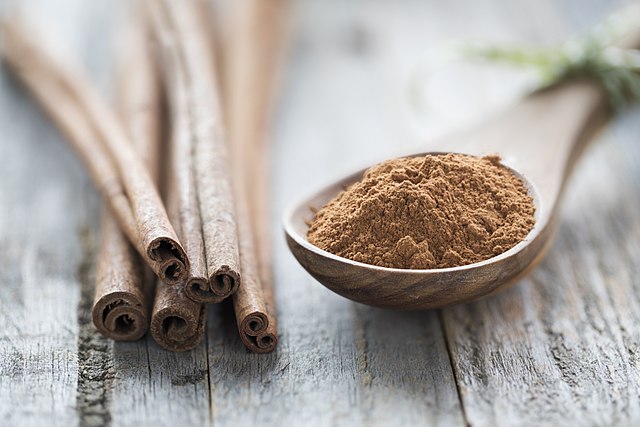
- Sprinkle cinnamon around the base of your seedlings to prevent the growth of fungi.
- Mix one tablespoon of 3% hydrogen peroxide solution with a quart of water and mist the potting soil before planting.
- Water your seedlings (from the bottom) with chamomile tea. Make a strong dose using three tea bags to one cup of water. Nettle tea also works against fungi.
- Garlic keeps vampires away, cures sore throats and helps your seedlings. First, crush a clove in a garlic press. Put the clove in a quart sized bowl and pour boiling water over it. Let it sit overnight. Strain the garlic pulp from the water and use the water to bottom feed your seedlings.
Studies have shown that Pythium can be reduced using mushroom bags. The next time you’re growing oyster mushrooms, place the spent bag in your garden and till in all those good fungal rhizomes.
Heat Treatment
Solarization is a process where you cover a section of your garden with plastic, causing the ground underneath to heat up. The heat kills pathogens and weed seeds. Try this method in late spring and early summer.
If you plan to solarize a section of your garden, till it first and then
If you’re USDA or NOP certified you might want to double check with your state agency. Temporary and seasonal use of solarization is an allowed USDA Organic practice. You are required to note this process on your Farm Plan and remove plastic at the end of the growing season.
Keep in mind that this is a different process than using solar mulch. OMRI approved solar mulches are used to heat the ground slightly and are popular for melons and other heat-loving crops.
Similar Diseases
Sometimes you can mistake other diseases for damping off. This is understandable as there are a lot of fungal diseases that affect plants. High levels of salts that accumulate in your garden and over-fertilization can also cause plants to topple. You’ll know it’s not root rot if there’s damage to leaves or the upper stem.
Greenhouse Plants
Damping off can occur in the garden soil and in potting soil. It’s also common in greenhouses.
I start my plants in an inside potting room under lights. They have access to heat and air circulation. When they get their true leaves, and the weather cooperates, I move them out to the greenhouse.
I have to be careful when I do this because the humid atmosphere of the greenhouse encourages soil pathogens to grow. Having good air circulation in your greenhouse can help discourage them.
In addition, keep growing surfaces sanitized in the greenhouse as like you do in the potting room.
Damping off is a frustrating disease, but you can conquer it by using preventative techniques. Follow the recommendations in this guide and your seedlings will flourish.


